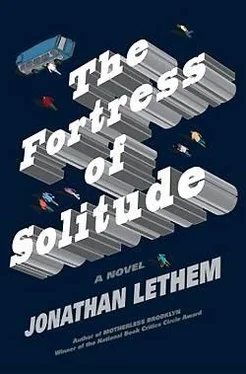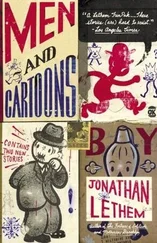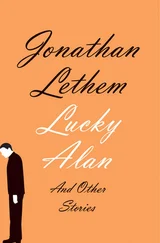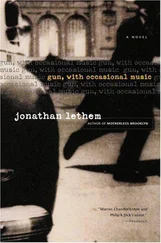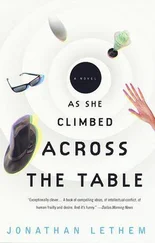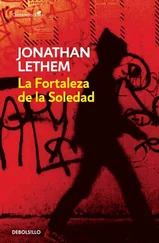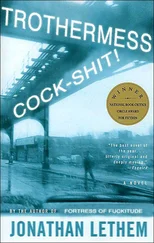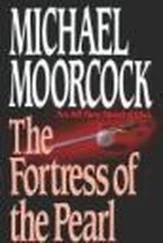“Not bad,” said Abraham Ebdus’s son. His tone suggested he’d read plenty that were worse. And then, in an act of almost unbearably dry wit, the boy returned the book carefully to the spot on the floor where Abraham had thrown it, covered his mouth with his fist and mimicked a slight cough, and turned to his dinner.
The book lay there through dinner, at sea between their feet. Later, after the television was on, Dylan safely established at his pew in the church of The Six Million Dollar Man , Abraham retrieved the book and slipped it into his back pocket, carried it upstairs to his studio. There he cleared a row of ink bottles from a shelf just above eye level, at the desk where he painted film. Neural Circus would have company soon enough: he’d already painted three more jacket designs for the New Belmont Specials, and a fourth lay in rough form on a table across the room. He couldn’t consider it now.
He dipped his brush, and focused his hot, onion-stinging eyes on the small celluloid frame where he’d left off work. His film’s plot had lately turned to the banishment or purgation, by degrees, of color. By infinitesimal movements, small blottings and eclipses, black and gray were coming to dominate the zone above the horizon line at the center of the frame, and white and gray the zone below. What colors remained were muted, fading rapidly as though disheartened by the trend, their obvious death sentence. They’d seen the writing on the wall. First they came for the crimsons and I didn’t speak up, then they came for the ochres -
The New Belmont Specials were purgatory for the banished colors, Abraham decided now. By expelling onto the jacket designs his corruptest impulses-the need to entertain or distract with his paints, the urge to do anything with his paints apart from seeing through them to the absolute truth-he’d further purify his film. The published paperback art, he saw now, with a thrill that felt almost vindictive, would be a Day-Glo zombie standing in for his painting career, a corpse that walked. Meanwhile, thriving in seclusion, like a Portrait of Dorian Gray in reverse, would be the austere perfection of the unpublished, unseen film.
Mole-boy ventures out in springtime unprotected. Takes his chances. He folds a dollar into sixteenths and works it into a slot on the inside of his belt buckle, arms himself with a double bluff: two quarters in his pocket, and another fifty cents he’s willing to cough up tucked into his sock. Whatever it takes. This operation is routine. In his front pocket, though, the scrabbling furtive creature has a stash he’s nervous about, his hands eager, prickly. His own El Marko, jet-black, seal unbroken. At Pearl Paint on Canal Street the Saturday before, on a run for art supplies, the mole-child had gathered it up with a sketch pad and a long tin box of colored pencils. Abraham Ebdus paid for the lot, no questions asked.
It’s Saturday, not quite ten in the morning the fifth day of June. Sixth grade is nearly shed now, the I.S. 293 Annex a one-year carapace, like a gross bodily phase, a mistake. What’s the point of a one-year school? You couldn’t grow into any useful stature. Next year was what mattered now, always had been, if you’d only known. You were readying for seventh grade. The main building on Court Street, with Mingus Rude in the grade ahead. There you’d stand some chance. Maybe. Seventh grade: concentrate, bring it into being. Looking anywhere beyond that, to high school, the guilty muffled fantasy of girls, blond girls like the lost-not-forgotten Solvers, is likely unwise for a mole-creature looking to avoid getting yoked. Take it one step at a time, o creature of the depths.
Meantime, prepare to enter Mingus’s ranks. Earn your stripes, locate your name. Saturday morning you could dare to hope the kids in the projects were all still in their Jockey underwear, five to a couch, watching Merrie Melodies on black-and-white screens. The stink of the solvent factory on Bergen is the only thing loud today, the Puerto Ricans not yet assembled in front of Ramirez’s store, the vacant bus floating like a chubby mote in new-summer light toward Third Avenue. A morning like this one might be a safe time to bring your name into being, throw it up on a wall. Nevertheless, mole-boy moves with nothing short of usual caution. Day, night, doesn’t matter. Who knows how he’ll explain if he’s cornered and forced to empty his pockets, show the El Marko. The thing’s a stolen passport, a charm he hasn’t earned the right to carry.
Glancing behind, he moves up Nevins.
On the block of Pacific Street between Nevins and Third a couple of side-by-side empty lots had been converted into what was called a vest-pocket park. Really just a dent in the block’s façade of brownstones, a square of ungreen public space, full of an oddly deep sandpit and some modernistic climbing furniture made of heavily lacquered wooden beams, plus the conventional slide and swings. The vest-pocket’s floor was black rubber matting in squares, joined by jigsaw-puzzle hinges, and strewn everywhere with broken glass and stubbed cigarettes and evaporated puddles of urine that marked the site’s true life. The slide and swings and the bolted-down garbage bins and the brick of the walls that made the vest-pocket’s three sides were thick-layered with tags in spray paint and marker. A kid was widely regarded as an idiot for setting foot in that sand even in sneakers, forget barefoot. That’s if you entered the Venus Flytrap of the park at all. Mole-boy regards it as a zone he sees the less of the better, and it takes courage for him to enter it now, though a quick glance confirms he’s alone.
He fumbles the El Marko free of his pocket and looks for a clean spot.
The last square of untagged surface in the vest-pocket is low on the underside of the slide, the angle awkward-to-impossible. Knees bent, he duckwalks into the slide’s shadow and uncaps. Smells the fresh reek of the black ink. He’s got a name ready, a secret with himself, practiced a thousand times the past two weeks, ballpoint on school desk, Sharpie marker on loose-leaf binder, bare fingertip in the air.
But this isn’t going to happen today.
Because today is the day the flying man falls from the roof.
First a shadow flashing at the corner of the boy’s eyes as he crouches under the slide, an immense bird- or bat-like stretch of black against the brick wall. Flight, reversed. Then a collapsing thud, someone thrown, and the wheezing sigh, the exhale thrown from a body by force of impact. The long sigh resolving into a moan. The boy starts, grazing his head on the slide’s underside, drops the marker. Caged in the slide’s shadow, he wonders if he could somehow hide there from the whatever.
Answer’s nope, he can’t.
“Little white boy,” groans the voice. “Whatchoo doin’?”
The flying man is huge, up close. He’s seated on the rubber matting and against the wall, a few feet away, knees up, two hands at his right ankle, rubbing. The skin of his knobby, flinty hands and at his ankle, at each of his ankles, bare above ratty red sneakers- rejects , in point of fact-is scaly, psoriatic, white tracing on alligator black. He’s dressed in jeans oiled gray with filth and a formerly white shirt, cuffs shredded, a button dangling by a thread. And over his shoulder, crumpled between his wide back and the brick wall, a bedsheet cape, knotted at the neck just like the kid in Where the Wild Things Are , only stained yellow. Unavoidably the boy thinks: pee -stained. And the flying man smells like pee, even worse than the park does.
The flying man grumbles again, looks up even as he goes on rubbing his ankle. His jaw is stubbled and pitted, curls of white boiled in dark acne. His nose points sideways. And where the flying man’s eyes ought to be white they’re that same pee-stain color, as though he’s somehow urinated even into his own eyeballs.
Читать дальше
